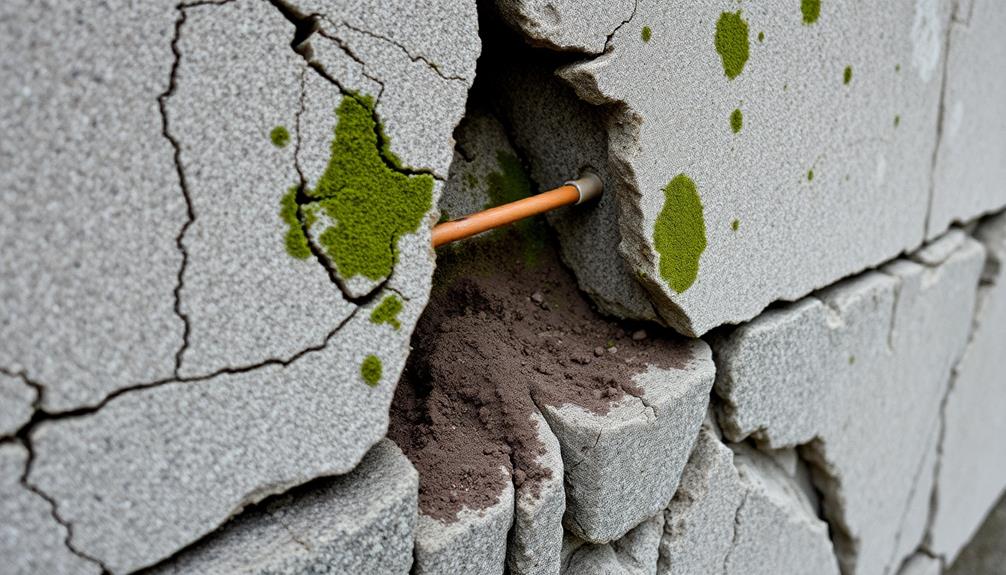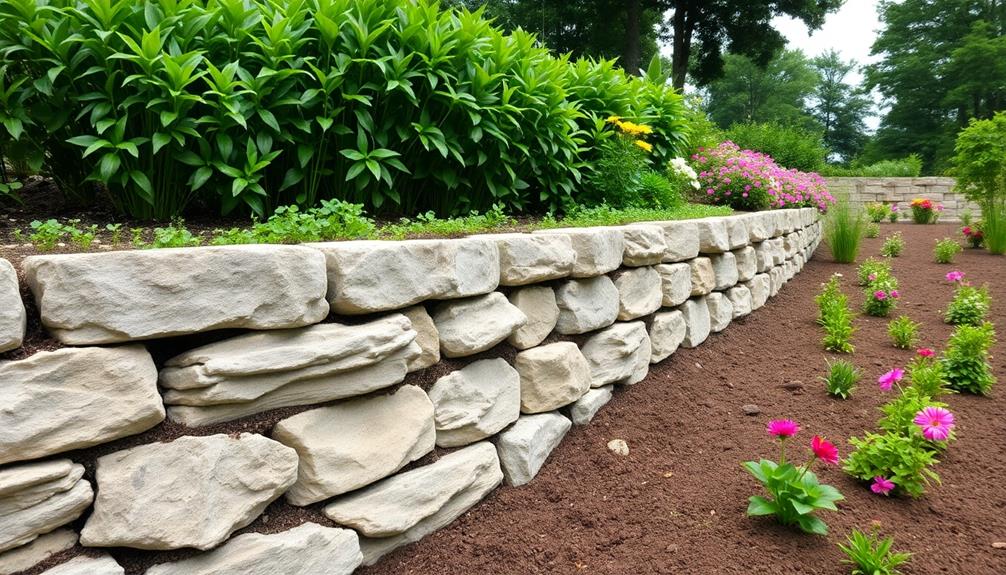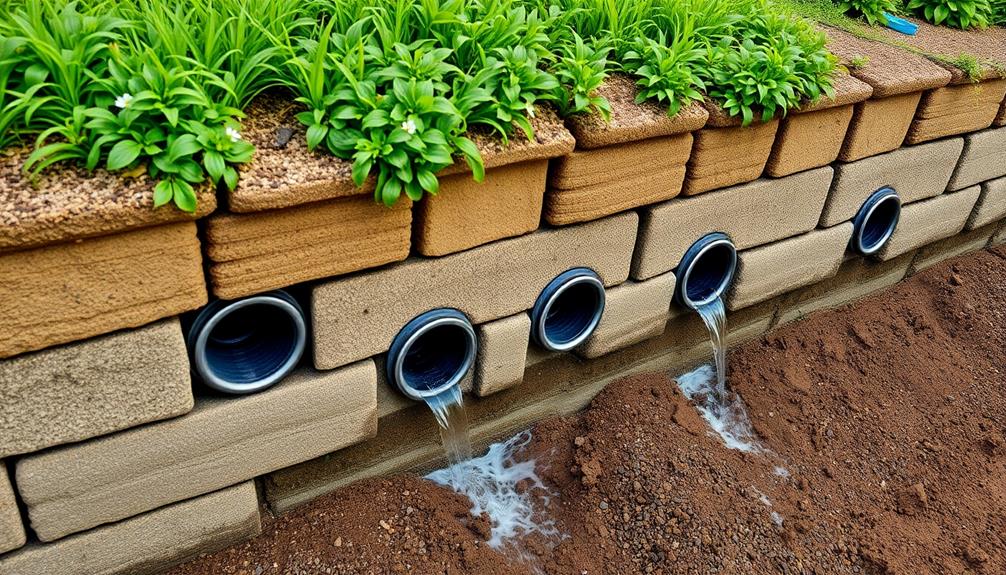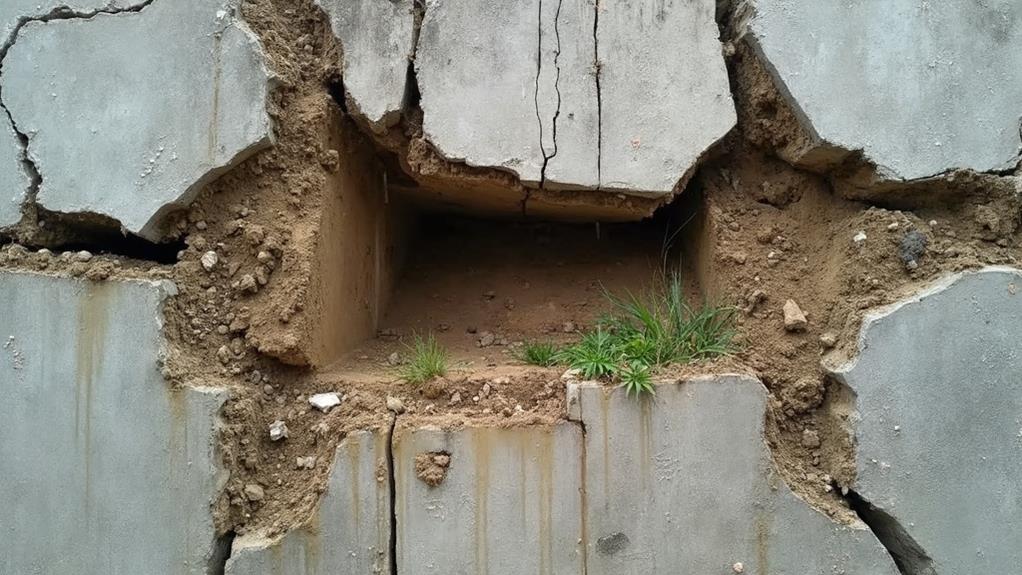Identifying common issues in retaining walls involves a fundamental inspection of key structural elements. Look for horizontal, vertical, or diagonal cracks, which can indicate excessive pressure, settlement, or soil instability. Water seepage manifests as damp patches, efflorescence, or biological growth, potentially compromising the wall's integrity. Bulging or leaning suggests excessive soil pressure or foundation problems. Regular maintenance of drainage systems, including clearing debris from outlets and weep holes, is pivotal for preventing water-related damage. Quantitative measurements using tools like plumb bobs can help detect subtle deformations. By understanding these indicators, property owners can take proactive measures to address potential problems before they escalate into more serious structural concerns.
Table of Contents
ToggleWalls Contractor Highlights
- Look for cracks in the wall, especially horizontal, vertical, or diagonal ones wider than 1/4 inch.
- Check for signs of water seepage, including damp patches, efflorescence, or biological growth on the wall surface.
- Observe any bulging or leaning of the wall, which may indicate excessive soil pressure or foundation issues.
- Inspect the drainage system for blockages or inefficiencies that could lead to water accumulation behind the wall.
- Monitor the wall's alignment regularly using tools like a plumb bob to detect gradual shifts or deformation.
Common Wall Deterioration Signs

Recognizing the early signs of retaining wall deterioration is essential for maintaining structural integrity and preventing costly failures. Key indicators of potential issues include the appearance of cracks and fractures, which may signal structural stress or settlement problems; water seepage issues that can compromise the wall's stability and lead to erosion; and noticeable bulging or leaning, which often suggests significant pressure buildup behind the wall.
In particular, boulder walls are an excellent choice because they are long-lasting and cost-effective, yet still require regular maintenance checks. These warning signs, when identified promptly, allow for timely intervention and remediation, potentially extending the lifespan of the retaining wall and ensuring its continued effectiveness in soil retention and erosion control.
Cracks and Fractures
Cracks and fractures in retaining walls are telltale signs of structural compromise that demand immediate attention. These fissures can manifest in various forms, ranging from hairline cracks to more substantial separations, each indicative of different underlying issues.
Horizontal cracks often suggest excessive lateral pressure, while vertical fractures may point to foundation settlement or inadequate drainage. Diagonal cracks, particularly those originating from corners, frequently indicate differential settlement or soil instability beneath the structure.
As conscientious property owners, it's pivotal to regularly inspect our retaining walls for these warning signs. By identifying cracks early, we can take proactive measures to prevent further deterioration and potential failure. It's critical to acknowledge that not all cracks are cause for immediate alarm; some may be the result of normal settling or thermal expansion.
However, cracks wider than 1/4 inch, those that display continuous growth, or any accompanied by bulging or leaning of the wall, warrant professional evaluation. Engaging a qualified structural engineer or masonry specialist guarantees a thorough assessment of the wall's integrity and appropriate remediation strategies, safeguarding our investments and the safety of our communities.
Water Seepage Issues
Three primary indicators of water seepage in retaining walls demand our attention: visible moisture, efflorescence, and biological growth. Visible moisture manifests as damp patches or water stains on the wall's surface, often accompanied by a noticeable deterioration of the surrounding material. Efflorescence, characterized by white, powdery deposits, occurs when water-soluble salts are drawn to the surface through capillary action and subsequently crystallize. Biological growth, including moss, algae, or mold, thrives in consistently damp environments and serves as a clear indicator of persistent moisture issues.
These signs of water seepage should not be overlooked, as they can lead to significant structural compromises if left unaddressed. The infiltration of water can weaken the wall's foundation, accelerate erosion, and potentially compromise its load-bearing capacity. Additionally, in colder climates, the freeze-thaw cycle can exacerbate damage, causing expansion and contraction that further deteriorates the wall's integrity. Identifying and addressing water seepage issues promptly is pivotal for maintaining the longevity and stability of retaining walls, ensuring they continue to effectively serve their intended purpose in landscape management and erosion control.
Bulging or Leaning
While water seepage can cause internal damage to retaining walls, external signs of deterioration are equally important to monitor. One of the most visible indicators of structural compromise is bulging or leaning in the wall's face. This deformation often results from excessive soil pressure behind the wall, inadequate drainage, or foundation settling. As a property owner or maintenance professional, it's pivotal to recognize these signs early to prevent catastrophic failure.
Bulging typically manifests as a noticeable outward curve in the wall's surface, while leaning presents as a uniform tilt away from the retained soil. Both conditions suggest that the wall is struggling to withstand the lateral earth pressure. Factors contributing to this issue may include improper design, substandard construction materials, or changes in soil conditions over time. Regular inspections can help identify these problems before they escalate. Measuring the wall's alignment with a plumb bob or level can provide quantitative data on the extent of deformation. If bulging or leaning is detected, it's imperative to consult a structural engineer promptly to assess the wall's stability and recommend appropriate remediation strategies, which may range from reinforcement to complete reconstruction.
Benefits

While retaining walls are often discussed in the context of their structural function and potential issues, they also offer significant benefits to property owners. For instance, they provide effective erosion control measures, preserving valuable topsoil and the integrity of the landscape over time.
These advantages include increased property value through improved land utilization and enhanced landscape aesthetics, which can transform previously unusable slopes into attractive, functional spaces. Additionally, retaining walls serve as an effective method of erosion control, protecting valuable topsoil and maintaining the integrity of the landscape over time.
Increased Property Value
Retaining walls can substantially enhance a property's value by improving both its aesthetics and functionality. These structures not only prevent soil erosion and create usable space on sloped terrain but also contribute to the overall appeal of a landscape. When properly designed and constructed, retaining walls can transform previously unusable areas into valuable outdoor living spaces, effectively increasing the property's square footage.
The increased property value resulting from well-implemented retaining walls can be attributed to several factors:
- Enhanced curb appeal and improved landscaping aesthetics
- Creation of additional usable space for gardens, patios, or recreational areas
- Mitigation of potential soil erosion and water drainage issues
Prospective buyers often view retaining walls as valuable assets, recognizing their dual purpose of functionality and visual appeal. These structures can create a sense of architectural cohesion within a property, seamlessly blending with existing landscaping elements. Additionally, retaining walls can serve as focal points, adding depth and dimension to outdoor spaces. By investing in high-quality materials and professional installation, property owners can guarantee their retaining walls remain durable and attractive for years to come, further solidifying their contribution to the property's long-term value.
Enhanced Landscape Aesthetics
Landscape transformation is one of the most significant benefits of retaining walls, enhancing the overall aesthetics of outdoor spaces. These structures serve as powerful tools for creating visually appealing and functional environments, seamlessly blending form with function.
By introducing varying levels and dimensions to an otherwise flat terrain, retaining walls add depth and interest to gardens, yards, and commercial properties.
The versatility of retaining wall materials, such as natural stone, brick, or concrete blocks, allows for customization that complements existing architectural styles and landscape designs. These walls can be engineered to incorporate built-in planters, seating areas, or water features, further elevating the visual appeal of the space.
Additionally, retaining walls provide an opportunity to showcase vibrant flora through tiered gardens or cascading plants, creating a lush, multi-layered landscape that captivates the eye and fosters a sense of natural harmony.
Moreover, well-designed retaining walls can effectively frame outdoor living spaces, delineate garden zones, and create intimate gathering areas. This structural enhancement not only improves the aesthetic value of the property but also contributes to a cohesive and inviting outdoor environment that residents and visitors alike can appreciate and enjoy.
Improved Land Utilization
One of the most significant benefits of retaining walls is their ability to dramatically improve land utilization. By creating level surfaces on sloped terrain, these structures enable property owners to maximize the usable area of their land. This enhanced functionality allows for a variety of practical applications, including:
- Expanded outdoor living spaces for recreational activities
- Additional parking areas or driveways on steep lots
- Increased agricultural productivity through terraced farming
Retaining walls effectively transform challenging topography into valuable, functional spaces. In urban environments, where land is at a premium, these structures can be particularly advantageous. They allow for the development of previously unusable hillsides, creating opportunities for new construction or expansion of existing facilities. Additionally, retaining walls can help mitigate erosion and stabilize soil, ensuring long-term land preservation and reducing maintenance costs associated with slope management. By optimizing land use, property owners can potentially increase their property values and create more versatile, efficient spaces. This improved utilization not only benefits individual landowners but can also contribute to more sustainable urban planning and development practices, fostering a sense of community pride in well-designed, functional landscapes.
Effective Erosion Control
Serving as a formidable defense against the relentless forces of nature, retaining walls play an indispensable role in effective erosion control. These structures strategically intercept and redirect water flow, considerably reducing soil displacement and preserving the integrity of landscapes. By implementing a well-designed retaining wall system, property owners can safeguard their investments and contribute to the overall stability of their surrounding environment.
Retaining walls achieve erosion control through multiple mechanisms. First, they physically block the movement of soil particles, preventing them from being carried away by water or wind. Additionally, these structures alter the topography of the land, creating a series of level surfaces that slow down water runoff and allow for better absorption into the ground. This not only mitigates erosion but also promotes healthier vegetation growth, further stabilizing the soil.
Moreover, retaining walls can be engineered to incorporate drainage systems, effectively managing excess water and preventing the buildup of hydrostatic pressure behind the structure. By addressing these critical aspects of erosion control, retaining walls offer an all-encompassing solution for maintaining land stability and preserving the aesthetic appeal of both residential and commercial properties.
Proper Drainage System Maintenance

Maintaining a proper drainage system is vital for the longevity and effectiveness of retaining walls. Regular inspections and maintenance of drainage components, including outlets, weep holes, and surrounding areas, are essential to prevent water accumulation and potential structural damage. The following table outlines key maintenance tasks, their frequency, and potential consequences if neglected:
| Maintenance Task | Recommended Frequency | Consequences if Neglected |
|---|---|---|
| Check for Clogged Outlets | Monthly | Water buildup, soil erosion |
| Inspect Weep Holes | Quarterly | Reduced drainage efficiency |
| Clear Debris Accumulation | Bi-annually | Blocked water flow, increased pressure |
Check for Clogged Outlets
Drainage system maintenance is essential for the longevity and stability of retaining walls. One critical aspect of this maintenance is regularly checking for clogged outlets. These outlets, designed to direct water away from the wall's foundation, can become obstructed over time, leading to potential structural issues. To guarantee optimal performance, property owners and maintenance professionals should conduct thorough inspections of drainage outlets, particularly after heavy rainfall or seasonal changes.
When examining drainage outlets, consider the following key points:
- Look for visible signs of blockage, such as accumulated debris, sediment, or vegetation growth
- Check for water pooling near the base of the wall, indicating improper drainage
- Inspect the surrounding soil for erosion or saturation, which may suggest inadequate water diversion
If clogged outlets are identified, prompt action is necessary to prevent water buildup and potential damage to the retaining wall. Clearing obstructions may involve manual removal of debris, pressure washing, or in some cases, professional intervention. Regular maintenance of drainage outlets not only preserves the integrity of the retaining wall but also contributes to the overall stability and aesthetics of the landscape, ensuring a well-maintained and functional outdoor space for property owners.
Inspect Weep Holes Regularly
In addition to checking drainage outlets, regular inspection of weep holes is a fundamental aspect of proper retaining wall maintenance. These small openings, strategically placed along the wall's face, play an indispensable role in alleviating hydrostatic pressure and preventing water accumulation behind the structure. As a conscientious property owner or manager, it is imperative to incorporate weep hole inspections into your routine maintenance schedule.
During these inspections, carefully examine each weep hole for signs of obstruction, such as soil, debris, or vegetation growth. Utilize specialized tools, like flexible wire brushes or compressed air, to clear any blockages and guarantee unimpeded water flow. Pay particular attention to weep holes located near ground level, as these are more susceptible to clogging from soil and organic matter.
Additionally, assess the surrounding area for indications of water seepage or erosion, which may suggest inadequate drainage performance. If you notice a consistent pattern of clogged weep holes or drainage issues, consider consulting a professional to evaluate the overall effectiveness of your retaining wall's drainage system and recommend potential improvements or modifications to enhance its longevity and structural integrity.
Clear Debris Accumulation
To guarantee the longevity and effectiveness of a retaining wall, vigilant removal of debris from the drainage system is paramount. Accumulated debris can impede water flow, leading to increased hydrostatic pressure and potential structural damage. Regular maintenance of the drainage system confirms optimal performance and prevents costly repairs.
When clearing debris, focus on the following areas:
- Weep holes and drainage pipes
- The area behind the retaining wall
- Surface runoff channels and catch basins
Implement a systematic approach to debris removal, utilizing appropriate tools such as pressure washers, drain snakes, and vacuum systems. Begin by carefully inspecting the entire drainage network, identifying potential blockages or areas of concern. Subsequently, methodically clear each component, ensuring thorough removal of leaves, sediment, and other obstructions.
For ideal results, schedule debris removal sessions based on seasonal factors and local environmental conditions. In areas prone to heavy foliage or frequent storms, more frequent maintenance may be necessary. By diligently adhering to a comprehensive debris removal regimen, property owners can significantly extend the lifespan of their retaining walls and mitigate the risk of structural failure, thereby safeguarding their investment and ensuring the continued stability of the surrounding landscape.
Walls Contractor FAQ
How Long Does a Typical Retaining Wall Last Before Needing Replacement?
The lifespan of a typical retaining wall varies depending on materials and maintenance. Well-constructed walls can last 50-100 years or more. Regular inspections and prompt repairs can markedly/considerably extend their longevity, ensuring your property remains stable and secure.
Can I Build a Retaining Wall Myself, or Should I Hire Professionals?
While DIY retaining walls are possible for small projects, professional assistance is recommended for larger or complex structures. Experts guarantee proper design, materials, and installation, ensuring safety and longevity. Your project's success is our community's shared interest.
What Materials Are Best for Constructing a Retaining Wall in Coastal Areas?
For coastal retaining walls, marine-grade materials are essential. Consider using concrete blocks, marine-grade timber, or fiber-reinforced polymer. These options resist saltwater corrosion and provide durability. Consult local experts to guarantee compliance with coastal construction regulations in your area.
How Often Should I Inspect My Retaining Wall for Potential Issues?
Regular inspections of your retaining wall are vital for its longevity and safety. As a responsible property owner, you should conduct visual checks at least twice a year, ideally in spring and fall, and after severe weather events.
Are There Eco-Friendly Options for Retaining Wall Construction and Maintenance?
Eco-friendly retaining wall options are increasingly popular among environmentally conscious homeowners. Materials like reclaimed wood, recycled plastic, and gabion cages filled with local stones offer sustainable alternatives. Regular maintenance using non-toxic sealants and natural drainage solutions further enhance eco-friendliness.







